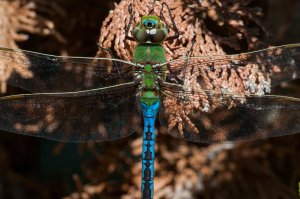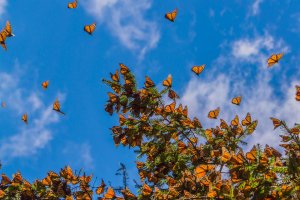Fall Migration – Insects
September 6, 2023
Samantha Volz, Park Interpreter
Fall is an energizing time of year. Crisp, cool air and changing leaves have many wanting to get outside and explore. Fall is also a time for many animals to make haste as they prepare for the coming winter season. There are three typical survival strategies for wildlife when the world gets colder – hibernation, migration, and tolerance. Hibernation is a strategy typically reserved for mammals such as the groundhog or chipmunk. Adaptations such as changing colors and diet, added fat reserves and smaller appendages help many animals tolerate and survive the winter months. There are a select number of animals that choose a different path for survival, and that is simply to leave or migrate to a different region instead, and that is who we are talking about today.
Migration simply put is when an animal or group of animals travels from one area to another. This typically involves animals traveling to northern regions in the spring for breeding and nesting, then returning to their wintering grounds each fall. The primary reason for migration is access to resources. Nesting requires enormous amounts of energy so birds will travel to areas with an abundance of insects, fruit, and seeds to feed themselves as well as their young offspring. A great majority of us have witnessed a flock of Canada Geese flying overhead in their V-formation while traveling to and from their wintering grounds, but there is another fascinating group of migrating organisms, the insects.
Many species of insects migrate throughout the globe, the largest groups being that of dragonflies, beetles, butterflies, and moths. That which drives our birds to migrate, the search for resources, may also motivate our insects. The ability for insects to migrate long distances is due to the presence of wings allowing for flight. One of the longest insect migrators is the Common Green Darner dragonfly. Starting in Canada and the Northern US, million of dragonflies will travel south towards the Gulf Coast and Mexico.
Another migratory insect is the aptly named Migratory Grasshopper. This species is widely distributed throughout North America and is found primarily in meadows and grassland habitat. This species migration can be seen when huge swarms gather in search of food. One of the longest migrations reported tracked a swarm moving a distance of over 500 miles.
Where insect migration can greatly differ from bird migration is the fact that the generation of insects that make it to their wintering grounds are not the generation to return for breeding. This is commonly seen in the Monarch Butterfly.
The Monarch Butterfly has one of the most well-documented migrations of any insect species. This is due to the love of the brightly colored butterfly, community science efforts as well as the desire to protect the population against numerous threats. Millions of Monarch Butterflies make the daunting journey to Mexico each fall where they can be found roosting in large groups referred to as kaleidoscopes. The ones who arrive in Mexico beginning in August are known as the 4th or “long-haul” generation. They are the longest lived of the monarch generations, spending up to 6 months wintering in Mexico, filling the trees with black and orange.

Breeding begins as the 4th generation monarchs migrate north from Mexico into the Southern United States, this is now the 1st generation. The cycle continues with generations 1-3, only living for about 30-45 days. This cycle repeats until once again the “long-haul” migrants are born in the north and return to Mexico as the great-great grandchildren of the monarchs in Mexico the year prior. As a part of community science efforts across North America, people can raise, capture and tag migrating monarchs who are then collected by scientist and volunteers in Mexico to determine where they came from and how long they are able to survive. You can report your sighting and join in these efforts by visiting Journey North.
Migration is a phenomenon still being studied worldwide whether it’s a Canada Goose or Monarch Butterfly there is still much to be known. Not only do scientists want to know the who, what, where and why of migration but also the effects that changing climates have on these species. Phenological cues are shifting as the world warms – it is yet to be determined how migration will change along with it. Get to know the migrants in your area and how you can help, their future generations may just depend on it.
